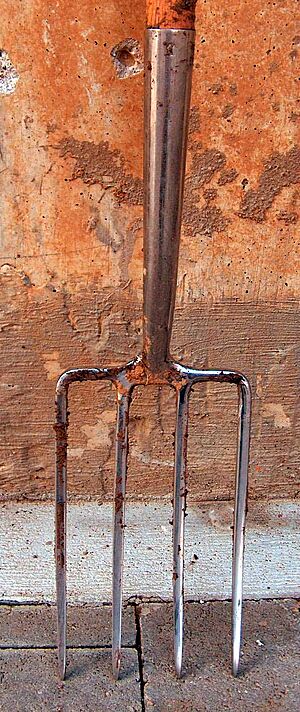Garden fork facts for kids
A garden fork is a super useful tool for anyone who loves to dig in the dirt! It's also sometimes called a spading fork or digging fork. People use it in gardens and farms to loosen up soil. Think of it like a spade, but it has several strong metal points, called tines, instead of a flat blade. This design makes it easier to push into the ground, especially when the soil is hard or full of roots.
One cool thing about garden forks is that they don't cut through plant roots as much as a spade does. This means you can dig around plants without harming them too much. Long ago, garden forks were made from wood, but today, most are made from strong steel so they can last a long time and handle tough jobs.
Garden forks are a bit different from pitchforks, which you might see on a farm. Pitchforks usually have longer, thinner tines that are spaced further apart, perfect for moving hay. Garden forks have shorter, thicker tines that are closer together, which is better for digging and breaking up soil.
Contents
What is a Garden Fork Used For?
Garden forks are amazing tools for many jobs in the garden. They help gardeners prepare the soil for planting new seeds or plants.
Breaking Up Hard Soil
If your garden soil is packed down and hard, a garden fork is perfect for breaking it up. The tines can easily push into the tough soil and loosen it. This makes it much easier for plant roots to grow and for water to soak in.
Removing Weeds and Old Plants
Garden forks are also great for pulling out weeds or old plants. You can push the fork into the ground around the plant, then gently lift it. This helps to get the whole root system out, which stops weeds from growing back quickly.
Mixing in Good Stuff
Gardeners often add things like compost or fertilizer to their soil to make it healthier. A garden fork is excellent for mixing these materials evenly into the ground. This makes sure all your plants get the nutrients they need to grow big and strong.
Harvesting Root Vegetables
If you grow root vegetables like potatoes or carrots, a garden fork is a gentle way to dig them up. Instead of slicing through them with a spade, the tines of the fork can carefully lift the vegetables from the soil without damaging them.
How to Choose a Garden Fork
When picking a garden fork, there are a few things to think about to make sure you get the best one for your needs.
Handle Length and Material
Garden forks come with different handle lengths. A longer handle can give you more leverage, which means less bending over and less strain on your back. Handles are often made of wood, fiberglass, or steel. Fiberglass and steel handles are usually very strong and durable.
Tine Strength and Shape
The tines are the pointy parts of the fork. They need to be strong, especially if you have rocky or very hard soil. Some forks have flat tines, while others have round or square tines. The shape can affect how easily they push into different types of soil. Thicker tines are generally stronger and better for heavy-duty digging.
Taking Care of Your Garden Fork
To make your garden fork last a long time, it's important to take good care of it.
- Clean it after use: After you're done digging, remove any dirt or mud from the tines and handle. You can use a hose or a stiff brush.
- Dry it properly: Make sure the fork is completely dry before storing it. This helps prevent rust, especially on steel parts.
- Store it safely: Keep your garden fork in a dry place, like a shed or garage. Hanging it up can save space and keep it from getting damaged.
- Sharpen the tines (sometimes): Over time, the tines might get dull. You can carefully sharpen them with a file to make digging easier again. Ask an adult for help with this!


